The AMD Radeon R9 Fury X Review: Aiming For the Top
by Ryan Smith on July 2, 2015 11:15 AM ESTFiji’s Architecture: The Grandest of GCN 1.2
We’ll start off our in-depth look at the R9 Fury X with a look at the Fiji GPU underneath.
Like the Hawaii GPU before it, from a release standpoint Fiji is not really the pathfinder chip for its architecture, but rather it’s the largest version of it. Fiji itself is based on what we unofficially call Graphics Core Next 1.2 (aka GEN3), and ignoring HBM for the moment, Fiji incorporates a few smaller changes but otherwise remaining nearly identical to the previous GCN 1.2 chips. The pathfinder for GCN 1.2 in turn was Tonga, which was released back in September of 2014 as the Radeon R9 285.
So what does GCN 1.2 bring to the table over Hawaii and the other GCN 1.1 chips? Certainly the most well-known and marquee GCN 1.2 feature is AMD’s latest generation delta color compression technology. Tied in to Fiji’s ROPs, delta color compression augments AMD’s existing color compression capabilities with additional compression modes that are based around the patterns of pixels within a tile and the differences between them (i.e. the delta), increasing how frequently and by how much frame buffers (and RTs) can be compressed.
Frame buffer operations are among the most bandwidth intensive in a GPU – it’s a lot of pixels that need to be resolved and written to a buffer – so reducing the amount of memory bandwidth these operations draw on can significantly increase the effective memory bandwidth of a GPU. In AMD’s case, GCN 1.2’s delta color compression improvements are designed to deliver up to a 40% increase in memory bandwidth efficiency, with individual tiles being compressible at up to an 8:1 ratio. Overall, while the lossless nature of this compression means that the exact amount of compression taking place changes frame by frame, tile by tile, it is at the end of the day one of the most significant improvements to GCN 1.2. For Radeon R9 285 it allowed AMD to deliver similar memory performance on a 256-bit memory bus (33% smaller than R9 280’s), and for Fiji it goes hand-in-hand with HBM to give Fiji an immense amount of effective memory bandwidth to play with.
Moving on, AMD has also made some changes under the hood at the ALU/shader level for GCN 1.2. Many of these changes are primarily for AMD’s Carrizo APU, where task scheduling improvements go hand-in-hand with the AMD’s Heterogeneous System Architecture initiative and deliver improvements to allow the CPU and GPU to more easily deliver work to each other. Similarly, 16-bit instructions are intended to save on power consumption in mobile devices that use lower precision math for basic rendering.
More applicable to Fiji and its derivatives are the improvements to data-parallel processing. GCN 1.2 now has the ability for data to be shared between SIMD lanes in a limited fashion, beyond existing swizzling and other data organizations methods. This is one of those low-level tweaks I’m actually a bit surprised AMD even mentioned (though I’m glad they did) as it’s a little tweak that’s going to be very algorithm specific. For non-programmers there’s not much to see, but for programmers – particularly OpenCL programmers – this will enable newer, more efficient algorithms where when the nature of the work requires working with data in adjacent lanes.
But for gamers, perhaps the most significant architectural improvement to GCN 1.2 and thereby Fiji are the changes made to tessellation and geometry processing. There is no single silver bullet here – after going with a 4-wide geometry front-end in Hawaii, AMD hasn’t changed it for Tonga or Fiji – but AMD has put in quite a bit of effort in to improving how geometry data moves around within the chip and how it’s used, on the basis that at this point the limitations aren’t in raw geometry performance, but rather the difficulties in achieving that performance.
Much of this effort has been invested in better handling small geometry, whether it’s large quantities of small batches, or even small quantities of small batches. The inclusion of small instance caching, for example, allows the GPU to better keep small batches of draw calls in cache, allowing them to be referenced and/or reused in the future without having to go to off-cache memory. Similarly, AMD can now store certain cases of vertex inputs for the geometry shader in shared memory, which like small instance caching allows for processing to take place more frequently on-chip, improving performance and cutting down on DRAM traffic.
More specific to Fiji’s incarnation of GCN is how distribution is handled. Load balancing and distribution among the geometry frontends is improved overall, including some low-level optimizations to how primitives generated from tessellation are distributed. Generally speaking distribution is a means to improve performance by removing bottlenecks, however AMD is now catching a specific edge case where small amplification factors don’t generate a lot of primitives, and in those cases they’re now skipping distribution since the gains are minimal, and more likely than not the cost from the bus traffic is greater than the benefits of distribution.
Finally, AMD has also expanded the vertex reuse window on GCN 1.2. As in the general case of reuse windows, the vertex reuse window is a cache of sorts for vertex data, allowing old results to be held in waiting in case they are needed again (as is often the cases in graphics). Though they aren’t telling us just how large the window now is, GCN 1.2 now features a larger window, which increases the hit rate for vertex data and as a result further edges geometry performance up since that data no longer needs to be regenerated.
As with our R9 285 review, I took the time to quickly run TessMark across the x8/x16/x32/x64 tessellation factors just to see how tessellation and geometry performance scales on AMD’s cards as the tessellation factor increases. Keeping in mind that all of the parts here have a 4-wide geometry front-end, the R9 285, R9 290X, and R9 Fury X all have the same geometry throughput on paper, give or take 10% for clockspeeds. What we find is that Fury X shows significant performance improvements at all levels, beating not only the Hawaii based R9 290X, but even the Tonga based R9 285. Tessellation performance is consistently 33% ahead of the R9 290X, while against Tonga it’s anywhere between a 33% lead at high factors to a 130% lead at low tessellation factors, showing the influence of AMD’s changes to how tessellation is handled with low factors.


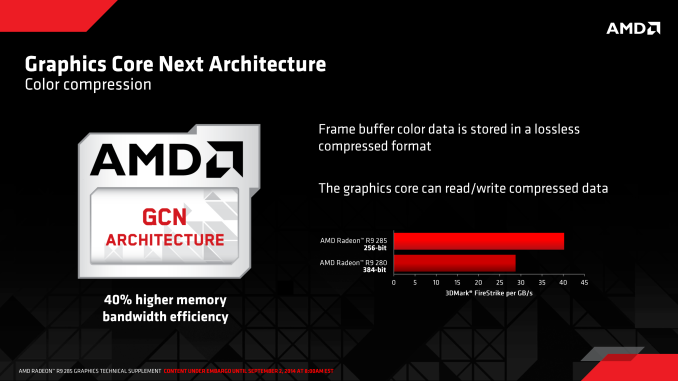
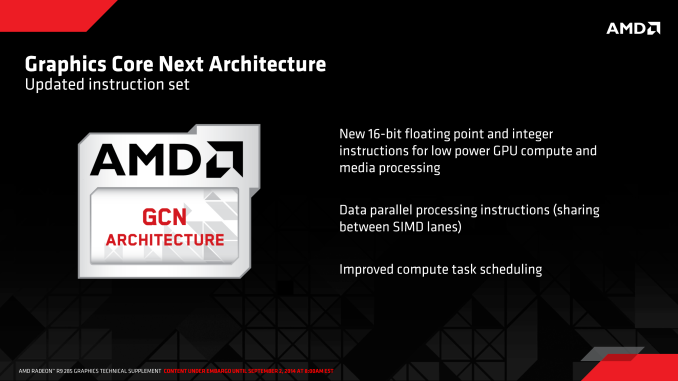
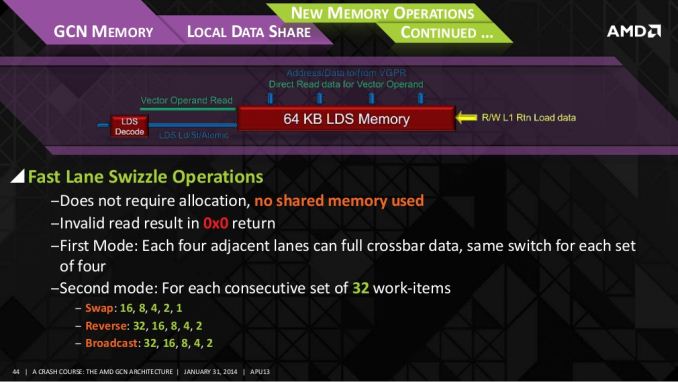
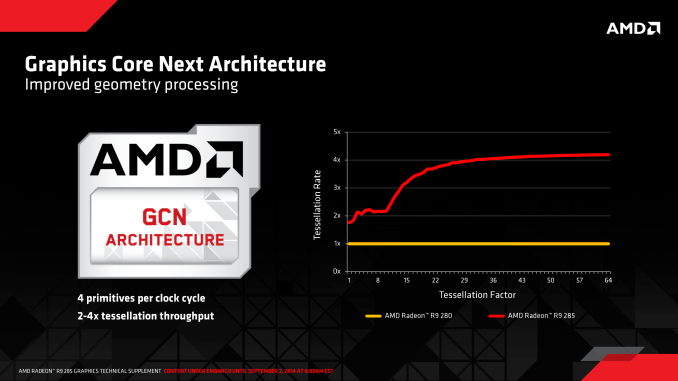
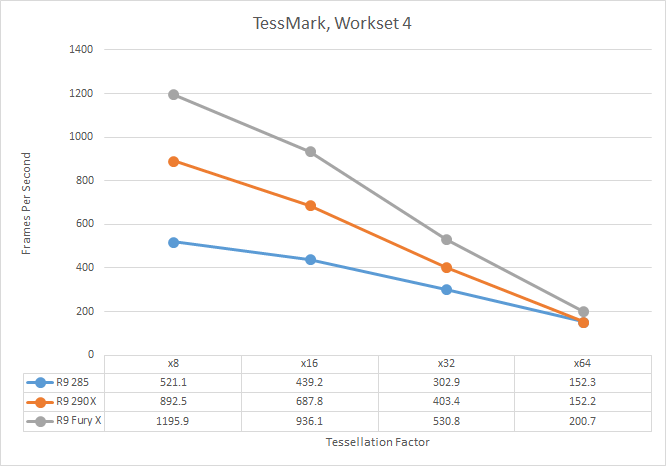








458 Comments
View All Comments
chizow - Monday, July 6, 2015 - link
Oh, and also forgot his biggest mistake was vastly overpaying for ATI, leading both companies on this downward spiral of crippling debt and unrealized potential.chizow - Monday, July 6, 2015 - link
Uh...Bulldozer happened on Ruiz's watch, and he also wasn't able to capitalize on K8's early performance leadership. Beyond that he orchestrated the sale of their fabs to ATIC culminating in the usurious take or pay WSA with GloFo that still cripples them to this day. But of course, it was no surprise why he did this, he traded AMD's fabs for a position as GloFo's CEO which he was forced to resign from in shame due to insider trading allegations. Yep, Ruiz was truly a crook but AMD fanboys love to throw stones at Huang. :Dtipoo - Thursday, July 2, 2015 - link
Nooo please put it back, it was so much better with Anandtech referring to AMD as the taint :PHOOfan 1 - Thursday, July 2, 2015 - link
At least he didn't spell it "perianal"Wreckage - Thursday, July 2, 2015 - link
It's silly to paint AMD as the underdog. It was not that long ago that they were able to buy ATI (a company that was bigger than NVIDIA). I remember at the time a lot of people were saying that NVIDIA was doomed and could never stand up to the might of a combined AMD + ATI. AMD is not the underdog, AMD got beat by the underdog.Drumsticks - Thursday, July 2, 2015 - link
I mean, AMD has a market cap of ~2B, compared to 11B of Nvidia and ~140B of Intel. They also have only ~25% of the dGPU market I believe. While I don't know a lot about stocks and I'm sure this doesn't tell the whole story, I'm not sure you could ever sell Nvidia as the underdog here.Kjella - Thursday, July 2, 2015 - link
Sorry but that is plain wrong as nVidia wasn't just bigger than ATI, they were bigger than AMD. Their market cap in Q2 2006 was $9.06 billion, on the purchase date AMD was worth $8.84 billion and ATI $4.2 billion. It took a massive cash/stock deal worth $5.6 billion to buy ATI, including over $2 billion in loans. AMD stretched to the limit to make this happen, three days later Intel introduced the Core 2 processor and it all went downhill from there as AMD couldn't invest more and struggled to pay interest on falling sales. And AMD made an enemy of nVidia, which Intel could use to boot nVidia out of the chipset/integrated graphics market by not licensing QPI/DMI with nVidia having nowhere to go. It cost them $1.5 billion, but Intel has made back that several times over since.kspirit - Thursday, July 2, 2015 - link
That was pretty savage of Intel, TBH. I'm impressed.Iketh - Monday, July 6, 2015 - link
or you could say AMD purposely finalized the purchase just before Core2 was introduced... after Core2, the purchase would have been impossibleWreckage - Thursday, July 2, 2015 - link
http://money.cnn.com/2006/07/24/technology/nvidia_...AMD was worth $8.5B and ATI was worth $5B at the time of the merger making them worth about twice what NVIDIA was worth at the time ($7B)
In 2004 NVIDIA had a market cap of $2.4B and ATI was at $4.3B nearly twice.
http://www.tomshardware.com/news/nvidias-market-sh...
NVIDIA was the underdog until the combined AMD+ATI collapsed and lost most of their value. They are Goliath brought down by David.